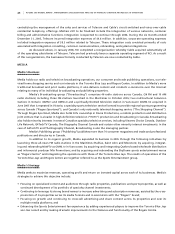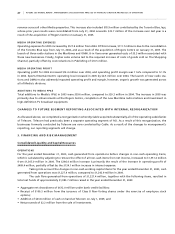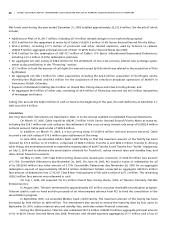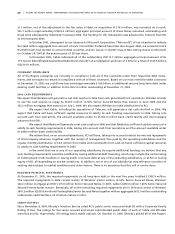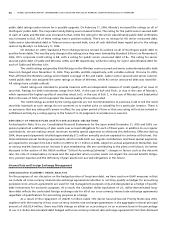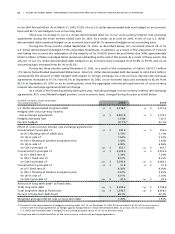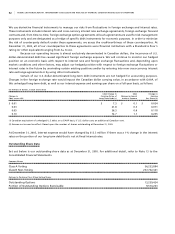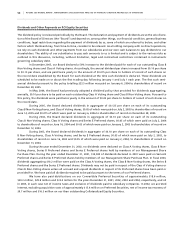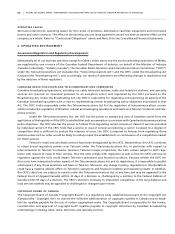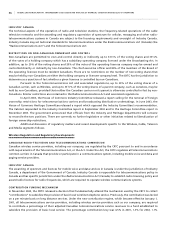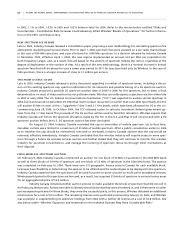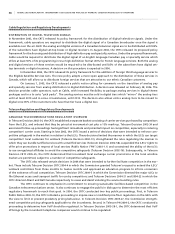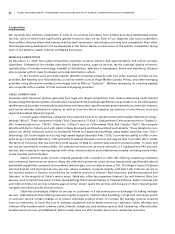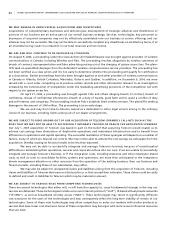Rogers 2005 Annual Report Download - page 59
Download and view the complete annual report
Please find page 59 of the 2005 Rogers annual report below. You can navigate through the pages in the report by either clicking on the pages listed below, or by using the keyword search tool below to find specific information within the annual report.
55 ROGERS 2005 ANNUAL REPORT . MANAGEMENT’S DISCUSSION AND ANALYSIS OF FINANCIAL CONDITION AND RESULTS OF OPERATIONS
OP E R AT I NG LE A S ES
We have entered into operating leases for the rental of premises, distribution facilities, equipment and microwave
towers and other contracts. The effect of terminating any one lease agreement would not have an adverse effect on the
company as a whole. Refer to “Contractual Obligations” above and Note 20 to the Consolidated Financial Statements.
4 . O P E R A T I N G E N V I R O N M E N T
Government Regulation and Regulatory Developments
Substantially all of our business activities, except for Cable’s Video stores and the non-broadcasting operations of Media,
are regulated by one or more of: the Canadian Federal Department of Industry, on behalf of the Minister of Industry
(Canada) (collectively, “Industry Canada”), the Canadian Radio-television and Telecommunications Commission (“CRTC”)
under the Telecommunications Act (Canada) (the “Telecommunications Act”) and the CRTC under the Broadcasting Act
(Canada) (the “Broadcasting Act”), and, accordingly, our results of operations are affected by changes in regulations and
by the decisions of these regulators.
CA N A DI A N R AD I O -T E LE V IS I O N A ND TE L E CO M MU N ICA T IO N S C OMM I SS I ON
Canadian broadcasting operations, including our cable television systems, radio and television stations, and specialty
services are licenced (or operated pursuant to an exception order) and regulated by the CRTC pursuant to the
Broadcasting Act. Under the Broadcasting Act, the CRTC is responsible for regulating and supervising all aspects of the
Canadian broadcasting system with a view to implementing certain broadcasting policy objectives enunciated in that
Act. The CRTC is also responsible under the Telecommunications Act for the regulation of telecommunications carriers
which includes the regulation of Wireless’ cellular and messaging operations and Cable and Telecom’s Internet and tele-
phone services.
Under the Telecommunications Act, the CRTC has the power to exempt any class of Canadian carrier from the
application of the legislation if the CRTC is satisfied that such an exemption is consistent with Canadian telecommunications
policy objectives. The CRTC also has the power to forbear from regulating certain services or classes of services provided
by individual carriers. If the CRTC finds that a service or class of services provided by a carrier is subject to a degree of
competition that is sufficient to protect the interests of users, the CRTC is required to forbear from regulating those
services unless such an order would be likely to unduly impair the establishment or continuance of a competitive market
for those services.
Telecom’s retail and wholesale services have been deregulated by the CRTC. Nevertheless, the CRTC continues
to retain broad regulatory powers over Telecom under the Telecommunications Act, in particular with respect to
interconnection to Telecom’s networks. However, Telecom’s major competitors, the ILECs, remain subject to CRTC regu-
lation with respect to many of their services. How the ILECs comply with regulation as well as how the CRTC enforces its
regulation against the ILECs could impact Telecom’s operations and financial condition. Because neither the CRTC nor
the courts have interpreted certain aspects of the Telecommunications Act and its regulations, it is impossible to predict
what impact, if any, these provisions will have on Telecom. Moreover, any change in policy, regulations or interpretations
could have a material adverse effect on Telecom’s operations and financial condition and operating results. In addition,
the CRTC’s decisions are subject to review under the Telecommunications Act at any time and may be appealed to the
Federal Court of Appeal (Canada) within 30 days of a decision or challenged by a petition to the Federal Cabinet of
Canada within 90 days of a decision. The CRTC’s decisions necessary to implement competition in the long distance and
local services markets may be appealed or challenged or changed upon review.
CO P Y RI G HT BO A R D O F C AN A D A
The Copyright Board of Canada (“Copyright Board”) is a regulatory body established pursuant to the Copyright Act
(Canada) (the “Copyright Act”) to oversee the collective administration of copyright royalties in Canada and to estab-
lish the royalties payable for the use of certain copyrighted works. The Copyright Board is responsible for the review,
consideration and approval of copyright tariff royalties payable to copyright collectives by Canadian broadcasting
undertakings, including cable, radio, television and specialty services.


